In Search of Maryada Purushottam
I ride to Ayodhya, solo… from 28 March to 04 April 2022. I shall come face to face with myself and my questions about Dharma, Maryada and Being Me. The conundrum, the complexity of what Dharma is, and the identity of Prabhu Sri Ram, the Maryada Purushottam, is at the heart of the idea of Maryada itself. “The Ideal Man” in my opinion will perhaps be the person who knows the limits of action and understands the boundaries of righteousness. Is the idea of the ‘ideal man’, somewhat static and limiting? Does it take into account changing times, places and circumstances??
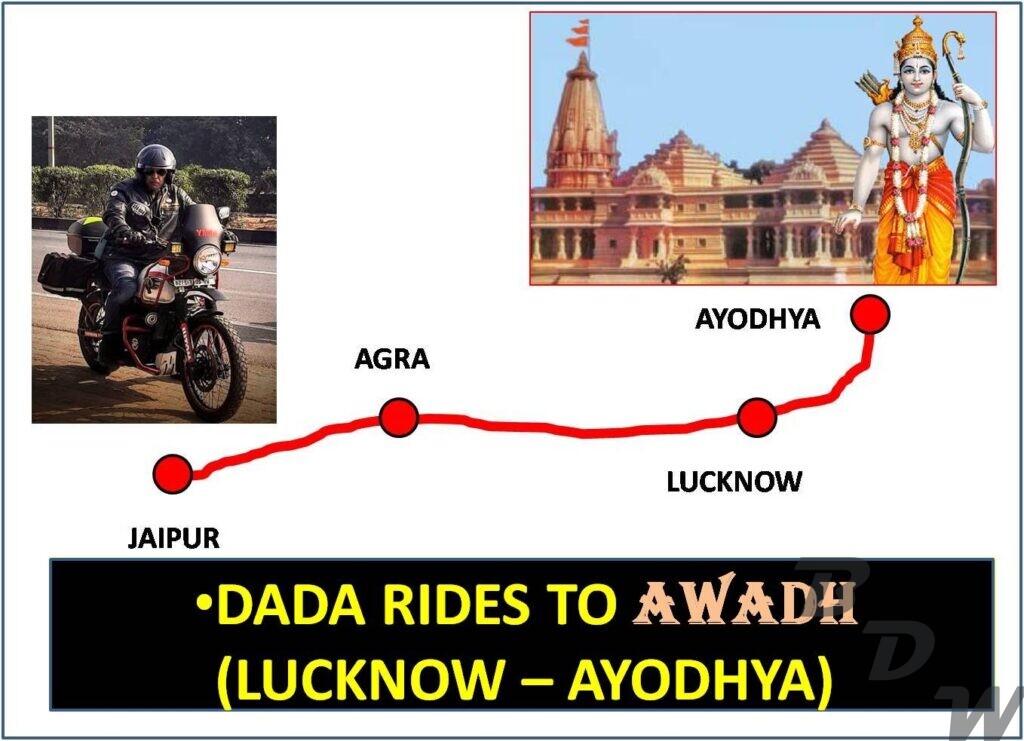
In Maryada, we discover that Dharma is perhaps contextual. It changes with situation and is dependent on relationships, and it is also in choosing which relationship. Apropos, does identity takes priority over action?? Kausalya, must choose between being a queen, wife and mother, her complexity is in which role will she act according to Dharma? How do we compare Surgriva and Vibhishana’s actions, both of whom betray their brothers, in the context of Dharma???
“What being a good person” means now, does it need to be the same, as it did 25 centuries ago?? It may not be the same thing for a man and a woman; a Dalit and an Upper Caste, a Rich and a Poor. Is Righteousness, identity based?? Or is it eternal and all pervading truth?? Is Maryada timeless, like Shiva?? Whatever be the case, does it mean that we shun the idea of being good all together? Or do we think of Ram as irrelevant?? How we read Ram now, in our own lives, does it depend on who we are and what we are looking for??
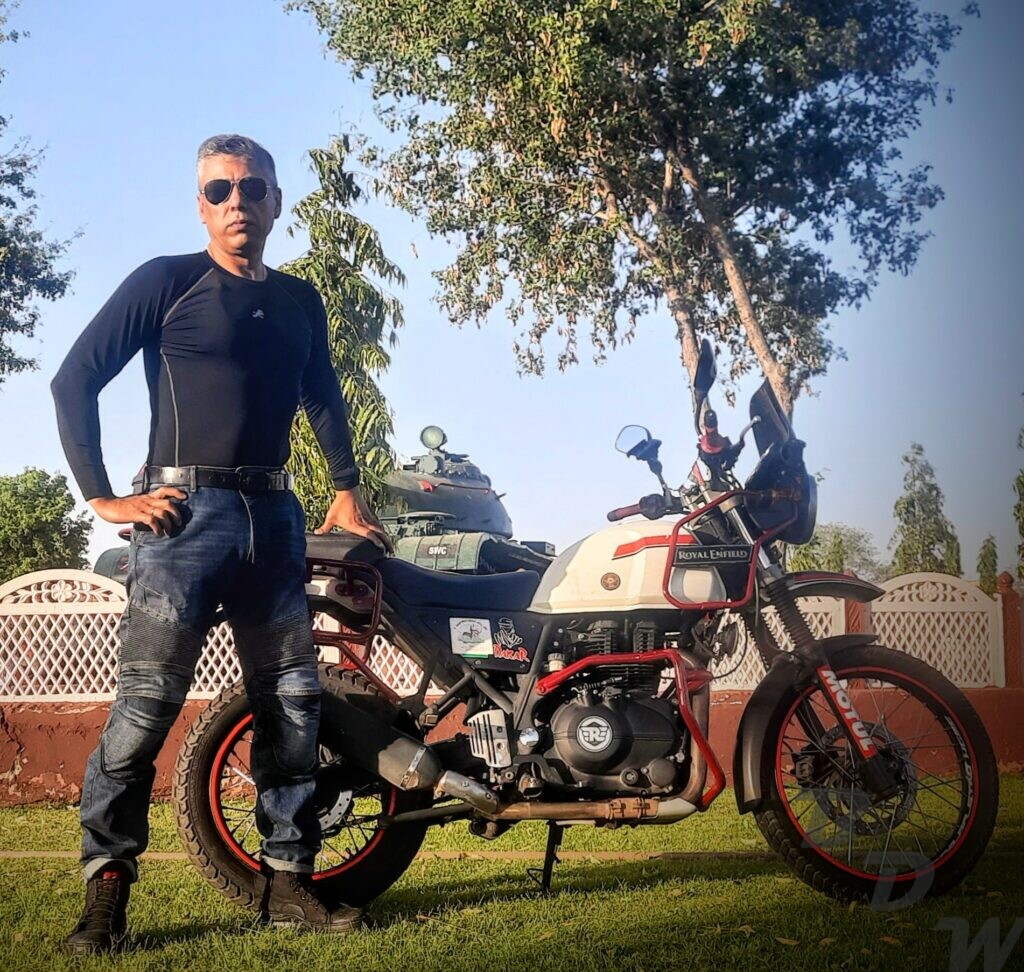
Setting Out
It was 3 am and the crescent moon was instigating the wolves and dogs to growl, as I set out for my journey. The daily weather being reasonably warm, I had expected things to be warm and windy. But that was not to be. As I sped through the open deserted highways, the wind chill shook my bones. I had to per force take a break for 30 minutes in a small tea shop warming up my palm with a warm cup of masala chai. Out came the only 2 T shirts that I carry and I had to wear them over the single skin I was riding on, so much for comfort. Once the sun was up, say at around 7 am; it was then that I could push Shwet Agni to 100+ kmph to make up for some lost time. The Jaipur Agra Highway otherwise is generally peaceful and event free…. thankfully.
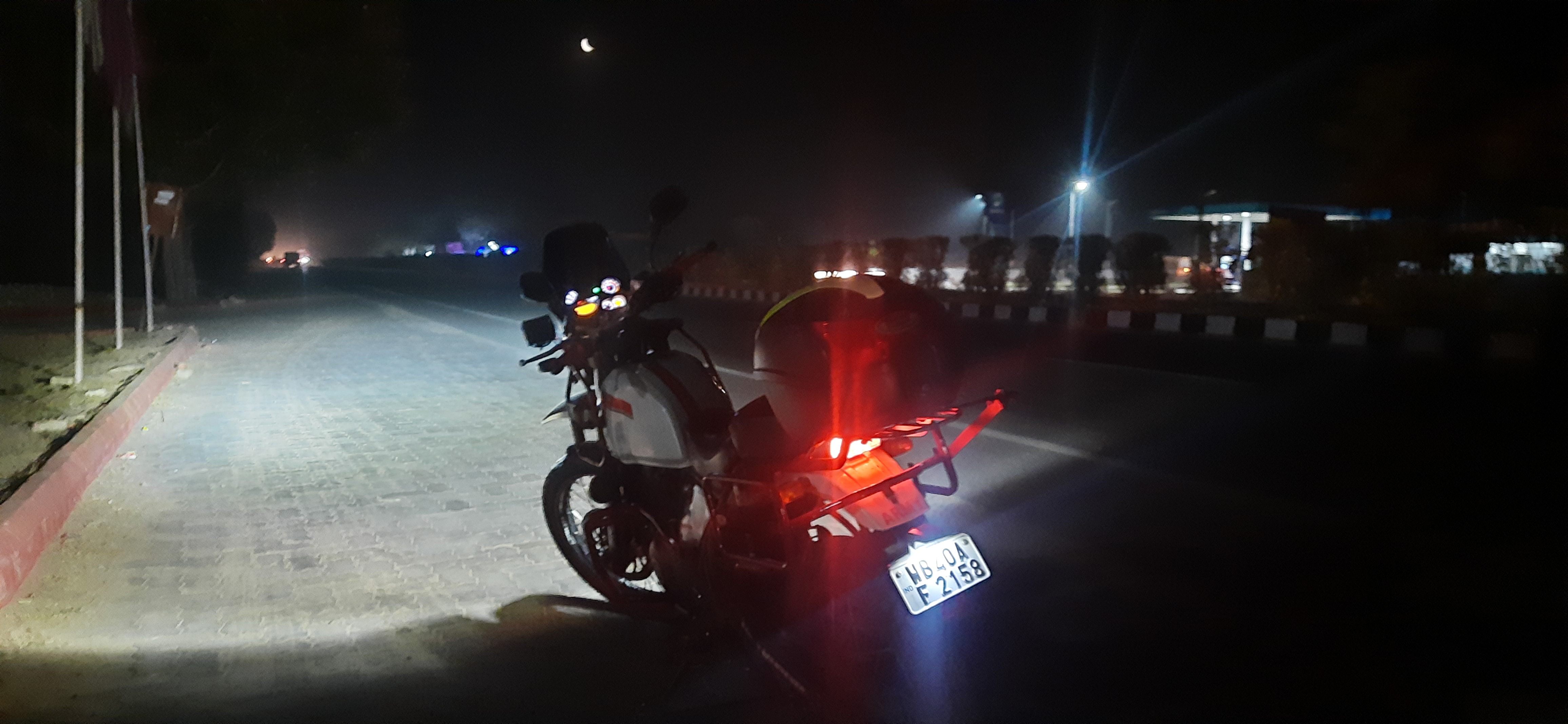
Heritage on The Road
We often talk of our heritage, uncared, unremembered and often clamored that we are not glorifying them enough. All of us must have read in our Class 8 History books about the indomitable Gurjara_Pritahara dynasty and one of the greatest kings of that dynasty Mihirbhoja. How many of us even care to know that the Gurjara Pritahara’s capital hub was exactly within the rectangle of the modern towns of Daussa, Bandikui, Alwar and Sikandra. It’s not that we are not told in our history books… it’s just that we do’nt associate that history and heritage lives right within us, we just need to open our eyes to see and feel heritage.
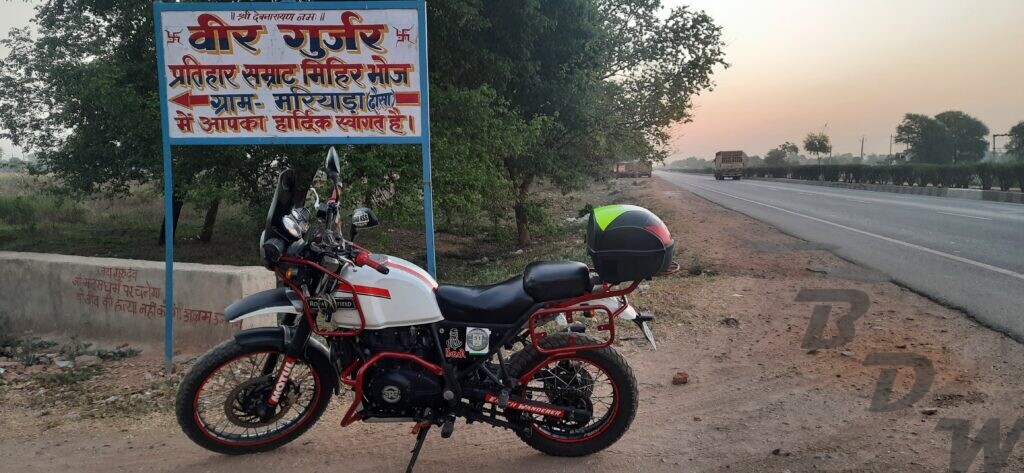
Bharatpur Bird Sanctuary
Enroute, the Bharatpur Bird sanctuary loomed large. I have never spent any quality time there, but had crossed it a hundred times. This time also, it was time to speed by, other than click a few photos on the gate itself.
Amongst one of the finest bird sanctuaries on the planet, Bharatpur Bird Sanctuary also called as Keoladeo Ghana National Park is a sanctuary that offers security to faunal species also. Keoladeo, the name gets from an old Hindu temple, which is dedicated to Lord Shiva and remains at the focal point of the national park. “Ghana” implies thick, alluding to the thick woods, which used to cover the region.
Settling indigenous water-feathered creatures and also transient water flying creatures and waterside winged creatures, this haven is likewise possessed by Sambar, Chital, Nilgai, and Boar. While a large portion of India’s park has been produced from the chasing predicament of royal India, Keoladeo, famously known as Bharatpur Wildlife Sanctuary, is maybe the main situation where the environment has been made by a maharaja. In 1760, an earthen dam (Ajan Dam) was developed, to spare the town, from this yearly idea of nature. The sorrow made by extraction of soil for the dam was cleared and this turned into the Bharatpur Lake.
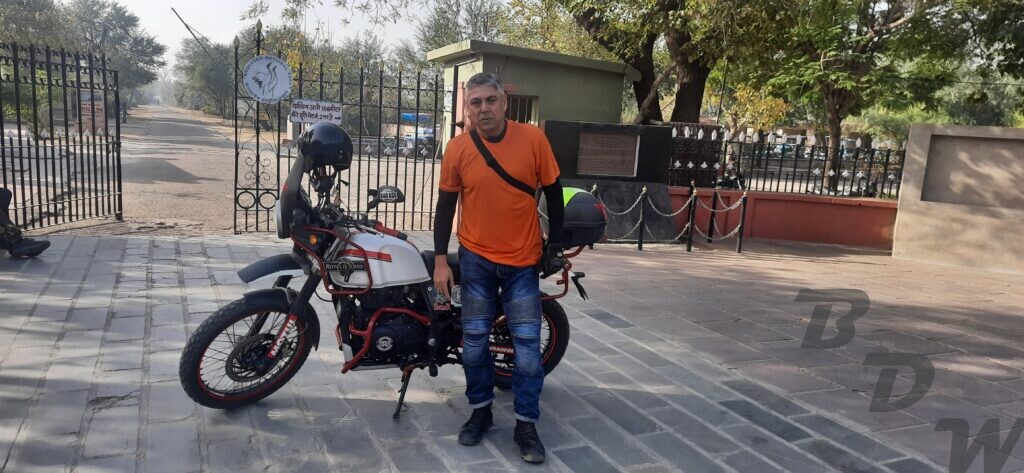
Fatehpur Sikri UNESCO Heritage Sight
Having appeared in the 16th century, the Mughal Empire had been trying to assert itself in the Southern Asia for more than 200 years. Huge territories were the object of great fights: first they were occupied, then in some period of time they were given to the enemies again. In between 1571 and 1585 Fatehpur-Sikri served as the main city of the Mughal Empire. Its name can be translated as the “City of Victory”. That was the name given by its founder — the third padishah, a descendant of Genghis Khan, the great grandson of Taimur — Akbar the Great. The one of the aims of the new city was to represent the triumph and grandeur of the Empire, so Akbar the Great hired the most famous masters, who managed to create the genuine pieces of art.
Nowadays Fatehpur-Sikri is a part of Uttar-Pradesh, The city is one of the very few well preserved examples of the Mughal architecture. It is characterised by the mixture of different local, Persian and Indian styles, which resulted in creation of the very refined buildings. Special attention was devoted to the symmetry and equilibrium of the different sections of houses, as well as the most sophisticated details of the decoration. The most famous example of this style is Taj-Mahal and Red Fort in Delhi, but Fatehpur-Sikri is not of the less interest.
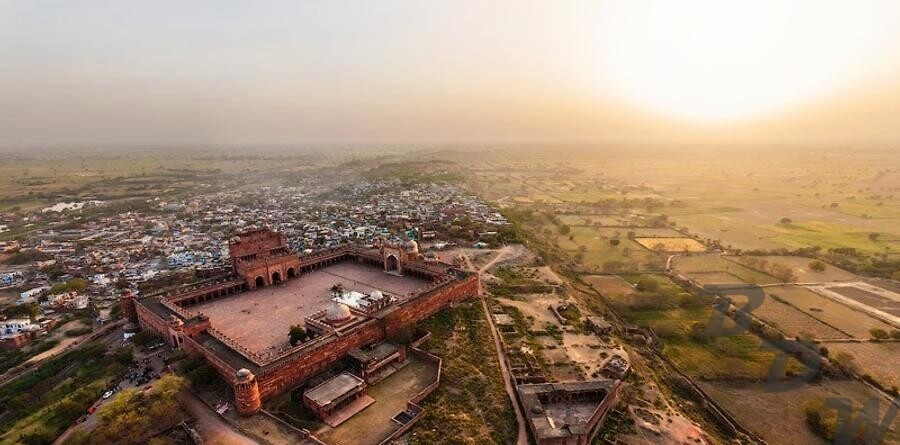
Agra – with her din and bustle
As I approach the city of Agra, the cacophony of regular Indian urban life welcomes me, as I venture through narrow cities with stray cattle, running children, scurrying two wheelers and screaming senior citizens. Almost 90 minutes of scuttling through the myriad settings and I manage to hit the Greater Agra Bypass leading me to the Agra Lucknow Expressway. All this, was not before I had the glimose of the magnificent Taj-Mahal from a distance.
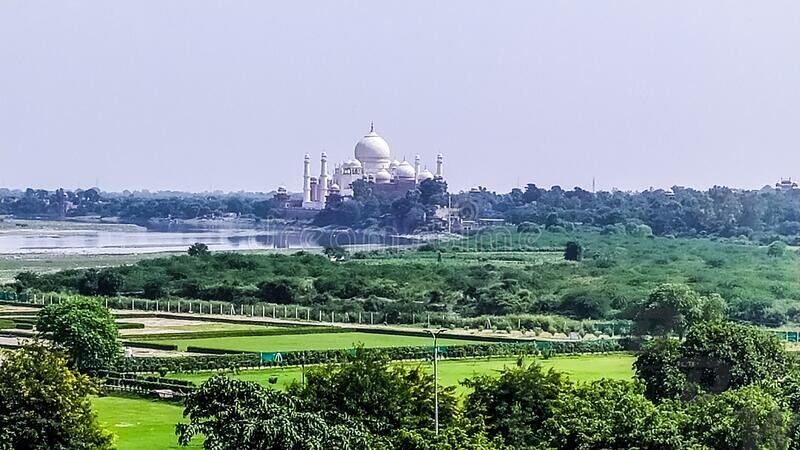
The Agra Lucknow Expressway
The Agra–Lucknow Expressway is a 302 km long, 6-lane wide (extendable to 8-lanes) access-controlled expressway constructed by the Uttar Pradesh Expressways Industrial Development Authority (UPEIDA) to reduce traffic in already congested roads and to reduce pollution and carbon footprint. The expressway reduced the distance between the cities of Agra and Lucknow in the Indian state of Uttar Pradesh and is presently one of the India’s longest operational expressways. This expressway is connected to Yamuna Expressway through the Agra Ring Road, and thus providing an express link between Greater Noida, NCR to Lucknow via Agra.
Agra and Lucknow via Shikohabad, Firozabad, Mainpuri, Etawah, Auraiya, Kanpur, Kannauj, Unnao and Lucknow. The expressway will start at village Etmadpur Madra near Agra and will end at village Sarosa Bharosa near Mohan Road, Lucknow.
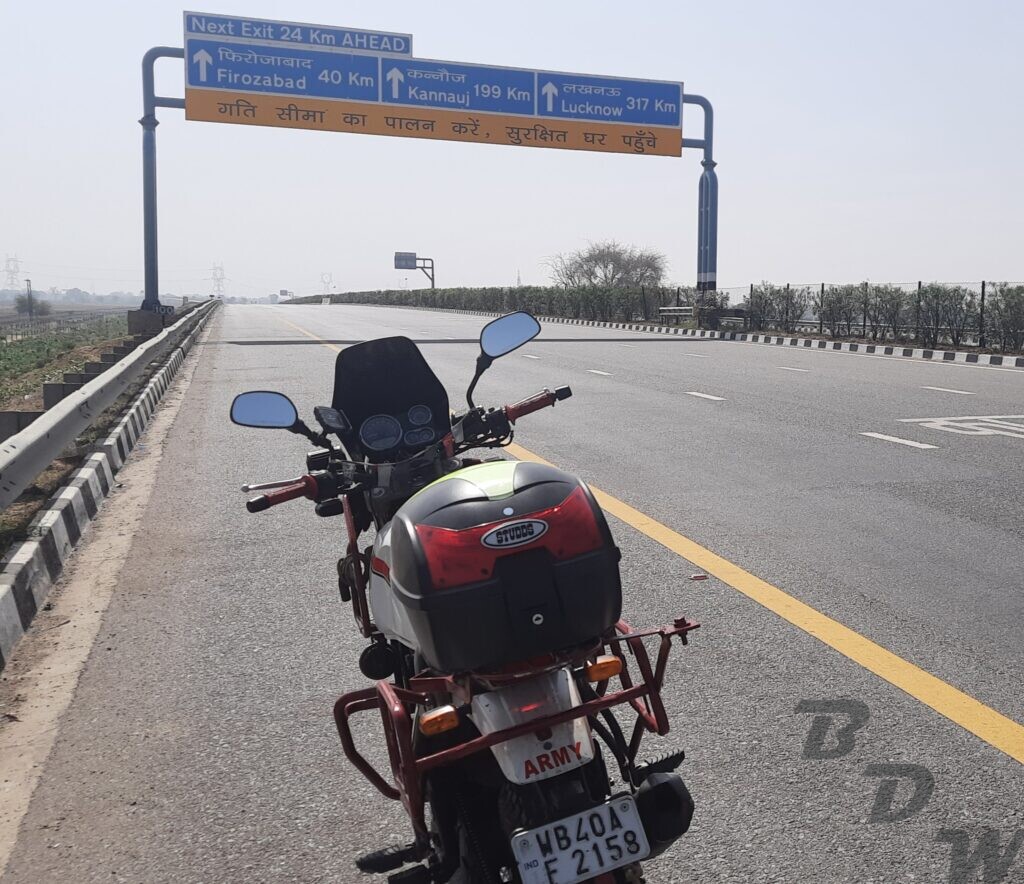
Rest Areas on Expressway
These are given below in direction of travel, as notably different from non-expressway custom. Services on one side of the road are only meant for travelers for that side of the direction of travel, so only services created on left of the road are available to you but not the same available while traveling in other direction, usually, a similar set of service is created on other side of road at same spot or within few km. of other side facility.
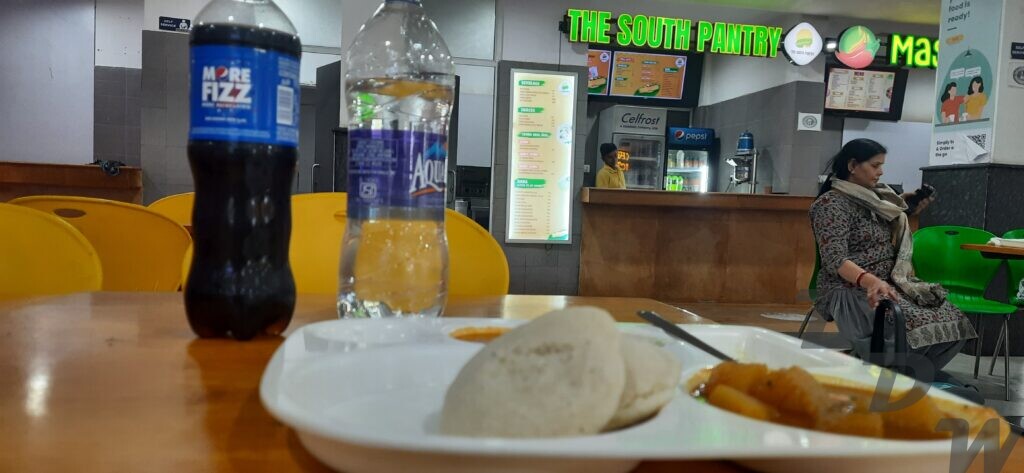
Eastbound (Agra to Lucknow) – There are two rest areas while going east:
1) About 100 km from Agra Toll Entrance
2) At 219 km from Agra Toll Entrance
Westbound (Lucknow to Agra) – These rest areas are available while going west:
1) At 105 km milestone from Lucknow toll entrance.
2) At 205 km milestone from Lucknow toll entrance.
Personal Experience on Expressway
Other than the rest areas mentioned above, which are approximately 105-110 km apart, there is not even a tree, for shade leave alone shops etc. However, I felt that one wouldn’t need to stop unnecessarily enroute. Petrol pumps are available only in the rest areas, or perhaps one may have to descend into the pre-existing exits. But then again that is not too much of a problem.
Speed limit is good, and high speed riding and driving is possible though not encouraged. Around 50-60 km apart, there are police patrol vehicles standing and overhead speed guns and cameras… and I think though not sure, I got the speeding tickets twice. Its a different thing though the joy I experienced when Shwet Agni chugged at nothing less than 130 kmph to do the entire stretch at around 4.5 hrs including eating and watering breaks.
The rest areas are eerily similar to the point of discomfort. I was confused, how come I landed up in the same place after riding for 100 plus kms. The food is average and ok priced, but what’s good is a good cool place to sit in the food court away from the sweltering heat outside, getting to use a clean washroom, access to cold water, soft drink, food and a petrol pump. Nice place, to take a short break.
Reaching Lucknow
The fast, yet rather boring journey through the expressway came to an end as Lucknow loomed into the Horizon. Lucknow, the capital of Uttar Pradesh, thrives along the banks of Gomti river. The city, Awadh and Uttar Pradesh fell to the British during the imperialistic era. Today Lucknow is dotted with remnants of its rich cultural past. Lucknow is also known for its elaborate cuisine and Chikankaari, or exquisite shadowwork embroidery on fine muslin cloth.
Lucknow is a historically important city and for many centuries was at the heart of North Indian culture. In particular, the city was famous for its Adab and Tehzeeb (manners and hospitality), intricate embroidery, beautiful gardens and dance forms such as Kathak. It was also one of the sites of the 1857 Indian Mutiny (or First War of Indian Independence). The Hindi spoken in Lucknow is considered the most beautiful and gentle in the country. Currently the city has a population of around 3.6 million.
Lucknow is the heart of the art, cuisine, dance, culture and music of Northern India. It was the cradle of the Hindu-Muslim-Sikh symbioses that made India great. it brought in the best of various cultures and accepted Western institutions like La Martiniere in her womb. It was made famous by the soft-spoken, and sweet tongued, Awadh-Lucknowai culture that was based on civilized behaviour toward fellow human beings. Lucknow is the home of Urdu, Hindustani and Hindi languages. The city became known as a centre for Urdu poetry and courtly presence and diction, being the birthplace and city of residence for many poets. The Mushaira, an event of poetry recitation forms the heart of Lucknow’s nightlife where Mushairas go on into the wee hours of the night. Lucknow’s only rival in Northern India was Delhi, though Lucknowies were always embroiled in a healthy rivalry with Delhi, home of the famous poet Ghalib and others. Lucknow is also famous for its sweetmeat, the sweet shops in the old city dates to 1850s. Awadhi and mughlai food is the delight of the visitors to Lucknow.

Bikers Meet
It was Babla da, a good friend and Biker who had organised my stay in a small yet comfortable Oyo sort of Hotel in Lucknow, in the heart of the modern city. It was there that a small, homely yet warm impromptu meet up happened with the Veteran Biker Colonel Sohan Ray, Babla Da, Fahim Zunaid and Self. Endless cups of tea, some Bacardi to go with and it was a fiesty early evening, not wanting to come to end soon.

The Night Drive around Lucknow to Gomti River front
Babla Da and his wife Chumki Maam played a great host, driving us around the grandeuse of Lucknow at night. What aroused my maximum interest was the Gomti River front. Gomti River front is a newly constructed park with some excellent asthetic attraction positioned in Lucknow. It was inaugrated on 16th october, 2016. Gomti Riverfront Park turned into built with the concern of renovation and develpoment of river Gomti, which is taken into consideration because the lifeline of Uttar Pradesh. The lush green surroundings across the banks of Gomti river that’s round 15kms long have been created as in keeping with International Standards.
The park stretches over two kms in area. Its predominant enchantment is the musical fountain, which could be very massive and can be seen from both aspects of the river. The musical fountain attracts round 200-300 human beings on a regular foundation. Other center includes a huge ability amphitheater, biking and walking tracks, boating, play region for kids and so on. It lets in the site visitors to experience the splendor of river Gomti, its a peaceful and a fantastic hangout vicinity for individuals, friends and family. The night light scenario from top was an easy late night attraction for me.
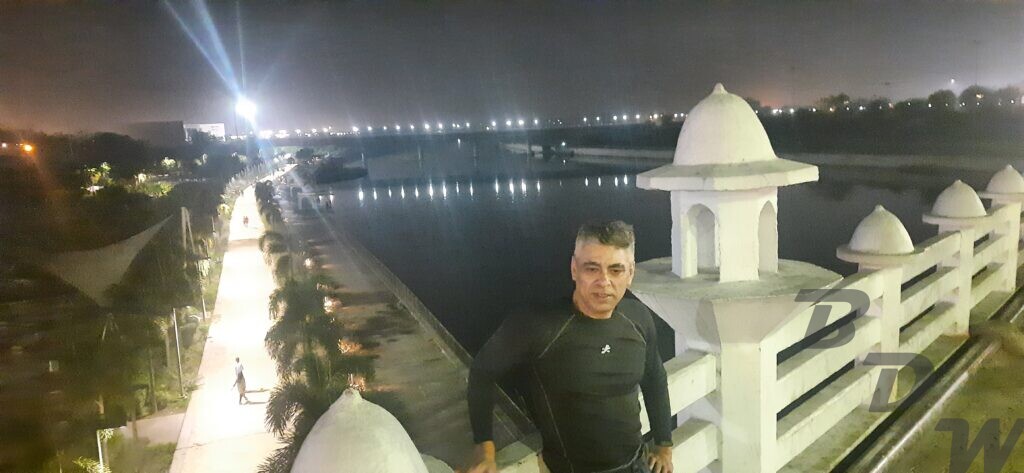
Lucknow to Ayodhya
Till the time the Purvanchal Expressway is not operational, my option was to take the NH to Ayodhya the next morning bang through the “Ganna” or Sugarcane belt. Around 120 odd km to Faizabad, the sister town of Ayodhya…the road is nothing much to speak of. Miles after miles long que of tractors laden with sugarcane throng the road, which is strangely Cemented and not exactly black top as we know it. Perhaps, the only relief were a few shops of pyaaz pakora and kulhar chai near the toll gates which provides a break yo the monotony. Two and a half hours of patience, and one hits and checks in at the quaint town of Faizabad, to settle into a hotel to progress with the Ayodhya sojourn.
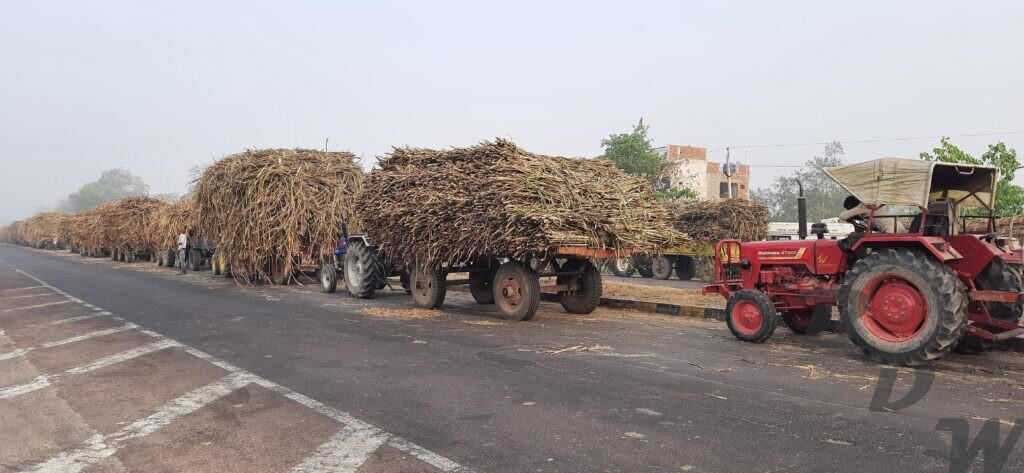
Faizabad
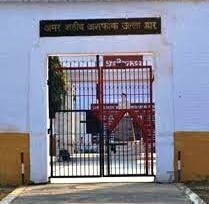
Faizabad was also a centre of one of many battles of the Mutiny of 1857. A detailed history of Faizabad can be read in ‘Tareekh-e-Farahbaksh’, written by Munshi Mohd. Faiz Baksh, (after whom Faizabad is named) a courtier in the Shuja-ud-Daula’s court. This book has been translated into English by Hamid Afaq Qureshi as ‘Memoirs of Faizab Khan, The Freedom Fighter Ashfaqulla Khan was hanged in Faizabad jail on 19 December 1927 for his role in the Kakori Train robbery on 9 August 1925.
Ayodhya
Hanuman Garhi
Hanuman Garhi is a 10th century temple of lord Hanuman in Uttar Pradesh, India. Located in Ayodhya, it is one of the most important temples in the city along with other temples such as Nageshwar Nath and the in-construction Ram Temple. Located in the middle of Ayodhya, 76 steps lead to the Hanumangarhi which is one of the most popular temple complexes of Hanuman in North India. It is a custom that before visiting Ram temple one should first pay visit to Lord Hanuman temple. The temple houses Hanuman’s mother, Anjani, with a young Hanuman sitting on her lap. This shrine is under the charge of Bairagi Mahants of Ramanandi Sampradaya and Nirvani ani akhara.
When Lord Rama returned to Ayodhya after conquering Ravana, Hanumanji started living here. That is why it was named Hanumangarh or Hanuman Kot. From here, Hanumanji used to protect Ramkot. In the main temple, Pawansut sits in the lap of Mata Anjani. This huge temple and its residential complex is spread over 52 bighas. Many temples of the country including Vrindavan, Nashik, Ujjain, Jagannathpuri have assets, akharas and meetings of this temple.
Hanuman Garhi temple is located very close to the Ram Janmabhoomi. In 1855, the Nawab of Awadh saved the temple from destruction by a group of Muslims who thought Hanumangarhi had been built over a mosque. Historian Sarvepalli Gopal has said that the 1855 dispute was not for the Babri Masjid – Ram Temple site but for the Hanuman Garhi temple. This Dispute was between Ramanandi Bairagis and Muslims. The darshan of Hanumanji was good though it involved some amount of barefoot walking and pushing and jostling for space.
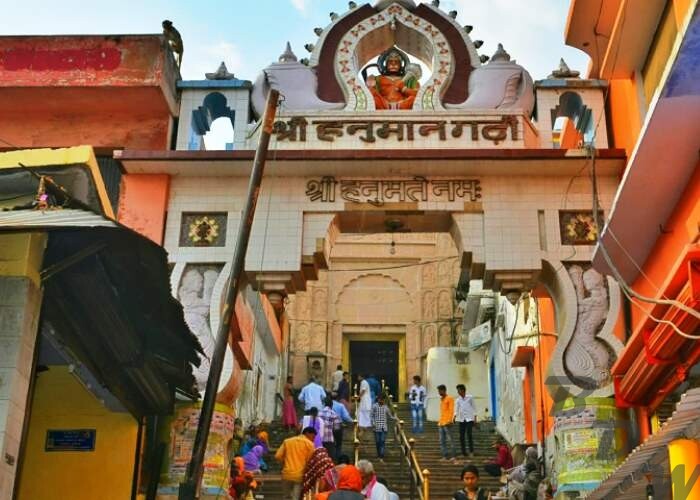
Hanuman Garhi
Background
According to the ancient Indian epic, Ramayana, Rama was born in Ayodhya. In the 16th century, the Mughals constructed a mosque, the Babri Masjid which is believed to be the site of the Ram Janmabhoomi, said to be birthplace of Rama. A violent dispute arose in the 1850s. In the 1980s, the Vishwa Hindu Parishad (VHP), belonging to the Hindu nationalist family Sangh Parivar, launched a new movement to reclaim the site for Hindus and to erect a temple dedicated to the infant Rama (Ram Lalla) at this spot. In November 1989, the VHP laid the foundations of a temple on land adjacent to the disputed mosque. On 6 December 1992, the VHP and the Bharatiya Janata Party organised a rally at the site involving 150,000 volunteers, known as kar sevaks. The rally turned violent, and the crowd overwhelmed the security forces and tore down the mosque. The demolition resulted in several months of intercommunal rioting between India’s Hindu and Muslim communities, causing the death of at least 2,000 people, and triggering riots all over the Indian subcontinent. A day after the demolition of the mosque, on 7 December 1992, The New York Times reported that over 30 Hindu temples across Pakistan were attacked, some set on fire, and one demolished. The government of Pakistan closed school and offices in a day of protest. Hindu temples in Bangladesh were also attacked. Some of these Hindu temples that were partially destroyed during the retaliation of Babri Masjid have since remained that way.
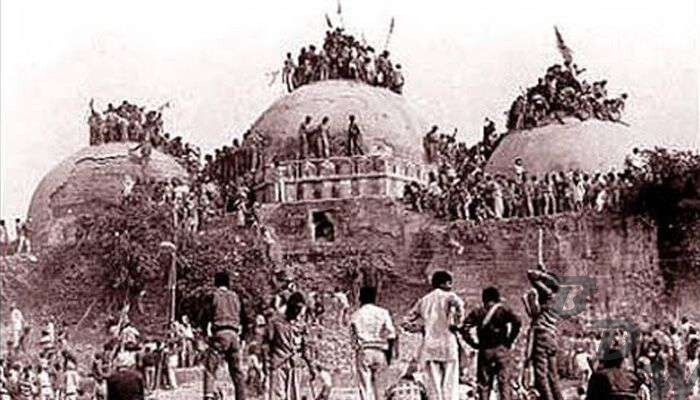
On 5 July 2005, five terrorists attacked the makeshift Ram temple at the site of destroyed Babri Mosque in Ayodhya, India. All five were shot dead in the ensuing gunfight with the Central Reserve Police Force (CRPF), while one civilian died in the grenade attack that the attackers launched in order to breach the cordoned wall. The CRPF suffered three casualties, two of whom were seriously injured with multiple gunshot wounds.
A 1978 and 2003 archaeological excavation by the Archaeological Survey of India (ASI) found evidence indicating that Hindu temple remains had existed on the site. Archeologist KK Muhammad accused several historians of undermining the findings. Over the years, various title and legal disputes also took place, such as the passage of the Acquisition of Certain Area at Ayodhya Ordinance, 1993. It was only after the 2019 Supreme Court verdict on Ayodhya dispute that it was decided the disputed land be handed over to a trust formed by the Indian government for the construction of a Ram temple. The trust was eventually formed under the name Shri Ram Janmabhoomi Teerth Kshetra. Five acres of land was allocated for the mosque 22 km away in the city in Dhannipur village. On 5 February 2020, it was announced in the Parliament that the Narendra Modi government had accepted a plan to construct the temple.
Prior construction efforts
In the 1980s, the VHP collected funds and bricks with “Jai Shree Ram” written on them. Later, the Rajiv Gandhi government gave the VHP permission for Shilanyas, with the then Home Minister Buta Singh formally conveying the permission to the VHP leader Ashok Singhal. Initially the centre and state governments had agreed upon the conducting of the Shilanyas outside of the disputed site. However, on 9 November 1989, a group of VHP leaders and Sadhus laid the foundation stone by digging a 200-litre (7-cubic-foot) pit adjacent to the disputed land. The singhdwar of the sanctum was laid here. Kameshwar Chaupal (a Dalit leader from Bihar) became one of the first people to lay the stone.
Deity
Ram Lalla Virajman, the infant form of Rama, an avatar of Vishnu, is the presiding deity of the temple. Ram Lalla’s dress is stitched by tailors Bhagwat Prasad and Shankar Lal; Shankar Lal is a fourth generation tailor to Rama’s idol. Ram Lalla was a litigant in the court case over the disputed site since 1989, being considered a “juristic person” by the law. He was represented by Triloki Nath Pandey, a senior VHP leader who was considered as Ram Lalla’s next ‘human’ friend.
According to the temple trust, the final blueprint includes temples dedicated to Surya, Ganesha, Shiva, Durga, Vishnu and Brahma in the temple premise.
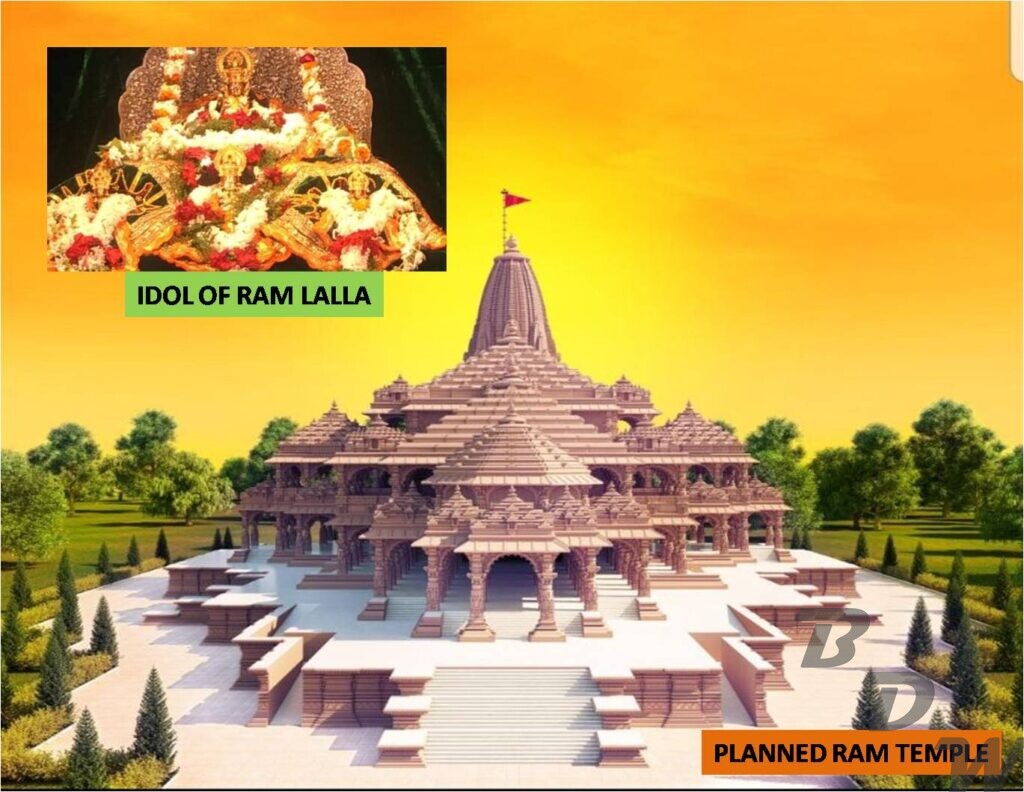
August 2021, a viewing location was created for the public to watch the construction. Following the ground-breaking ceremony, up to 40 feet of debris was removed and the remaining earth compacted. The foundation was made using roller-compacted concrete. A total of 47-48 layers, each layer one foot high, were completed by mid-September 2021. Due to electricity supply issues in Mirzapur, the process for cutting sandstones was slowed down. At the beginning of 2022 a video was released by the temple trust showing the planned construction of the temple in 3D along with other related information.
My Personal Experience
Waiting in que for over an hour with a multitude of Bhakts, was an experience in itself. The myriad conversation strewn with religion, mythology was an experience in itself. The quick walk around within the security fencing with zillions of security men and cameras was hardly a religious experience. Was grateful it ended peacefully.
The Kanak Bhawan Temple
The ‘Kanak Bhawan’ is the biggest, religiously one of the most important and architecturally an aesthetically built temple dedicated to Lord Ram and his divine consort Sita. It is located in the pilgrim holy town of Ayodhya in the state of Uttar Pradesh of India. This shrine is a marvelous sample of temple architecture and design, and is the most beautiful and attractive structure in Ayodhya. Its magnificence and charm is not only restricted to its external façade, but the deities installed in the sanctum are so beautiful and captivating to behold that one is left dumbfounded and spell-bound once one sees them. The enchantment of the divine view of the consecrated deities and their magnetic pull is of such intensity that the eyes of the beholder are riveted by their beauty, and he finds it difficult to move his eyes away from them. It is something to be experienced and not simply told and read, because the words have their own limitations, and something that has an ethereal and divine dimension cannot be put in shackles by the limitations of words. It becomes a sort of love at first sight when the visitor is compelled in his heart to make a promise to himself that he would come over and over again to experience and soak in this divine glory of the Lord as much as he can.

Kanak Bhawan Front view 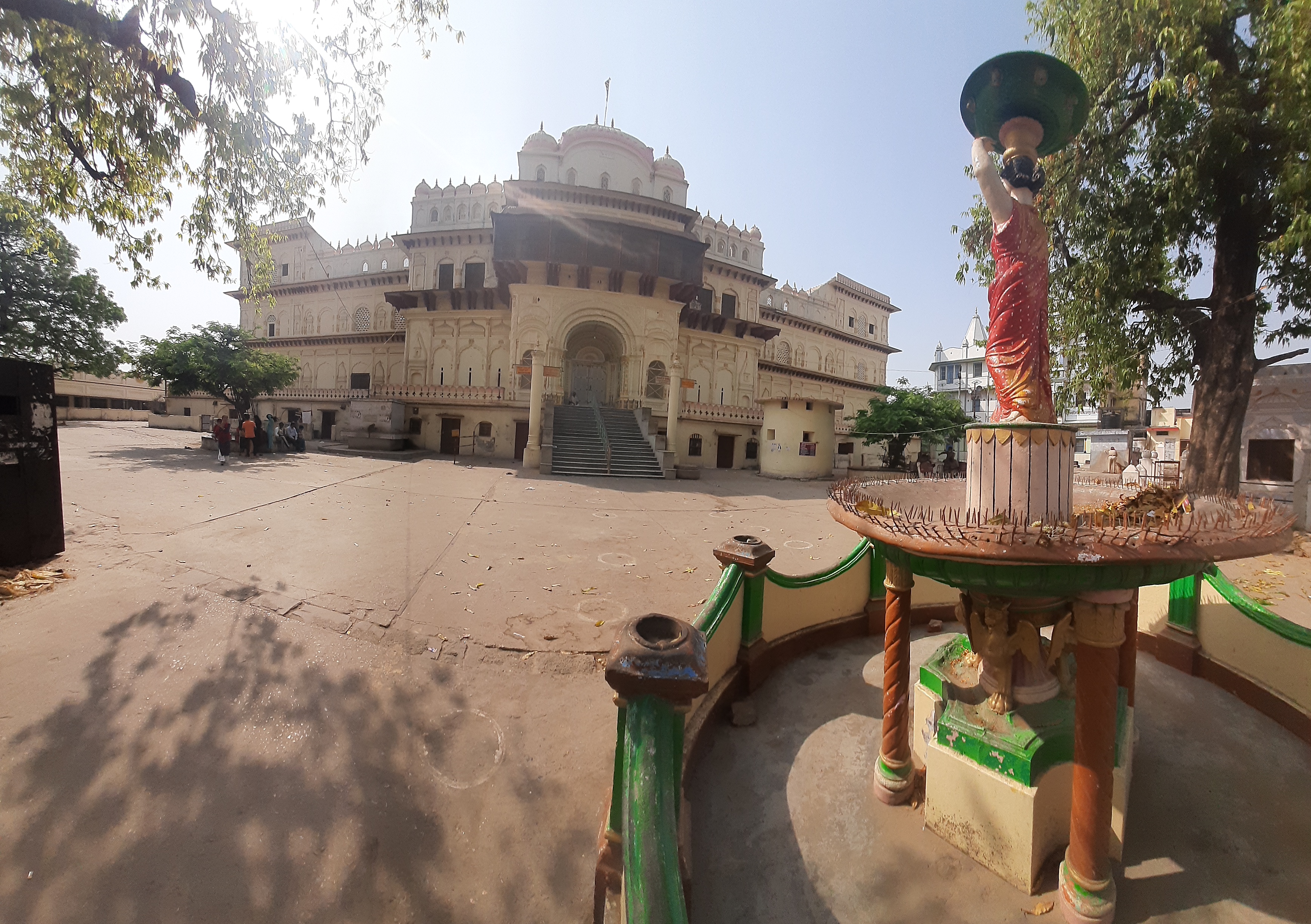
Kanak bhawan Panoramic view
Conceived more as a sprawling palace rather than as a shrine, the Kanak Bhavan Temple resembles magnificent palaces of Bundelkhand and Rajasthan region of India. Its history dates back to Treta Yug when it was gifted by Ram’s step-mother Kaikeyi to him and his consort Sita as a marriage gift. With the passage of time it fell to ruin, and was reconstructed and renovated many times. The first reconstruction was done by Ram’s son Kusha in the beginning of Dwapar Yug, again by King Rishabdeo in middle of Dwapar, and Lord Krishna is said to have visited the ancient site in pre-Kali Yug era 614.
In the current Yug called the ‘Kali Yug’, it was first built by Chandra Gupta Vikramaditya in Yudisthir era 2431, repaired & renovated by Samudra Gupta in 387 A.D. (V.S. 444), destroyed by Nawab S. Salarjung II Gazi in 1027 A.D. (V.S. 1084) and then finally reconstructed on the ruins & renovated in the present shape by H.H. Maharaja Sri Pratap Singh Ju Deo, G.C.S.I., G.C.I.E. of Orchha and Tikamgarh (Bundelkhand) and his Queen Maharani Vrisbhan Kunwari, and consecrated in 1891 A.D. (V.S. 1948) Vaishkh Shukl 6th, Guru Pushya (roughly the month of May).
There are three pairs of consecrated idols—and all of them are those of Lord Ram and Sita. The largest pair is the one installed by Rani Sri Vrishbhan Kunwari who was the moving force in the construction and establishment of this temple. The pair to its right is of a medium height and is said to be those which were established by King Vikramaaditya and were salvaged from destruction when that ancient temple was destroyed by invaders. The third pair is the smallest and is traditionally believed be the one that was given by Lord Krishna to a woman hermit who was meditating on Lord Ram at this site. Krishna instructed her to bury the idols in the ground when she leaves her mortal coil (body) so that later on they would be discovered and act as a mark to identify the sacred place when a king (who later turned out to be King Vikramaaditya) would set out to resurrect this holy place during Kali Yug. It so happened by providence that when Vikramaaditya was digging the foundation of his temple, this ancient pair emerged, and this helped this great king of India to locate the exact spot to establish the sanctum of his own grand temple.
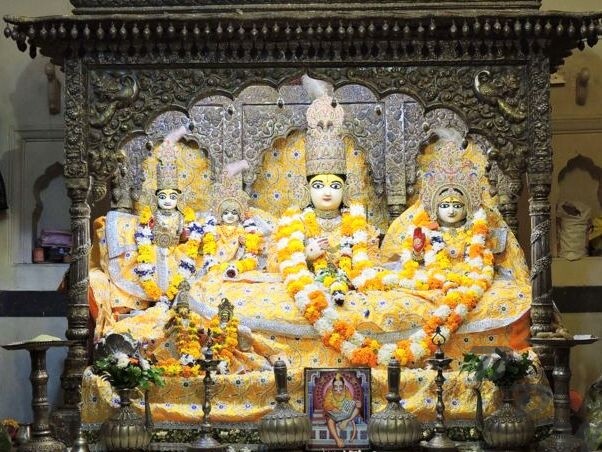
When the current temple was built, all these three pairs were installed in its sanctum sanctorum. All the three pairs are seen now. Due obeisance and worship are offered regularly to all of them daily in the temple. The temple is being looked after and managed by a Trust named “Sri Vrisbhan Dharm Setu Pvt. Trust” which was established by HH Maharaja Saheb Sri Pratap Singh Ju Deo of Orcha and Tikamgarh, who was its first president.
Saryu Ghat
The evening rolled into dusk by the Saryu river taking a look into the ghats ladedn with boats and Bhakts. Gave a skip to the boating invitations, but strolled along.
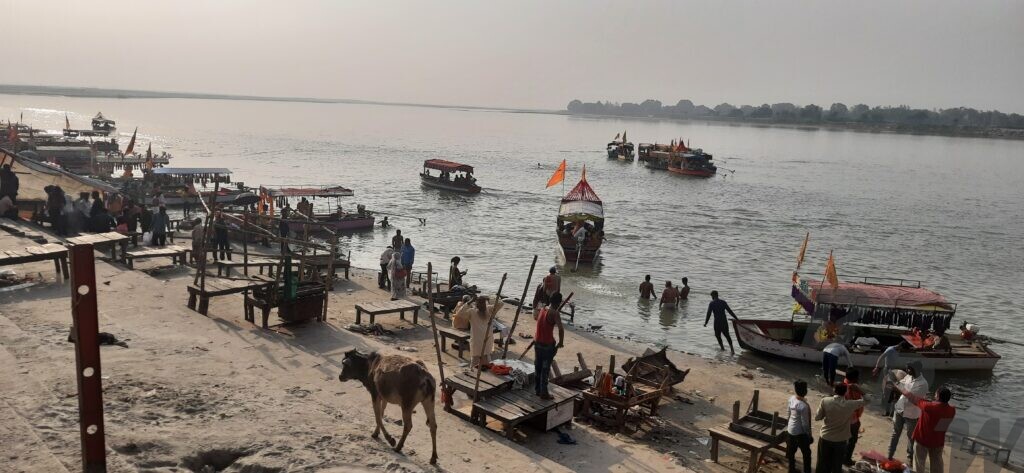
Saryu Ghat 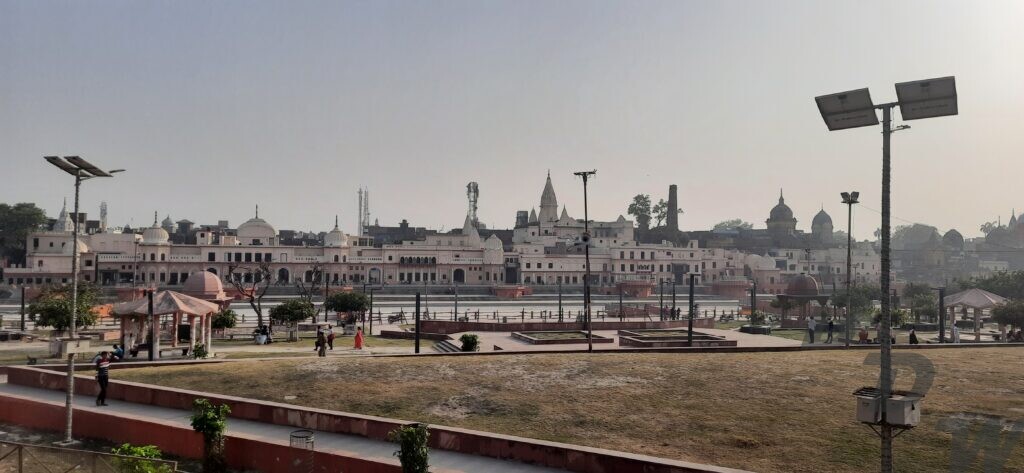
Saryu Ghat of Diwali Diya Spectacle
Bikers’ Sojourn
The evening was off course colourful with Ankit who was gracious to host me for a drink and sumptuous dinner besides handing me their club sticker and memento of the city. Long live Biker Brotherhood. Next morning it was time to be back to the City of nawabs.
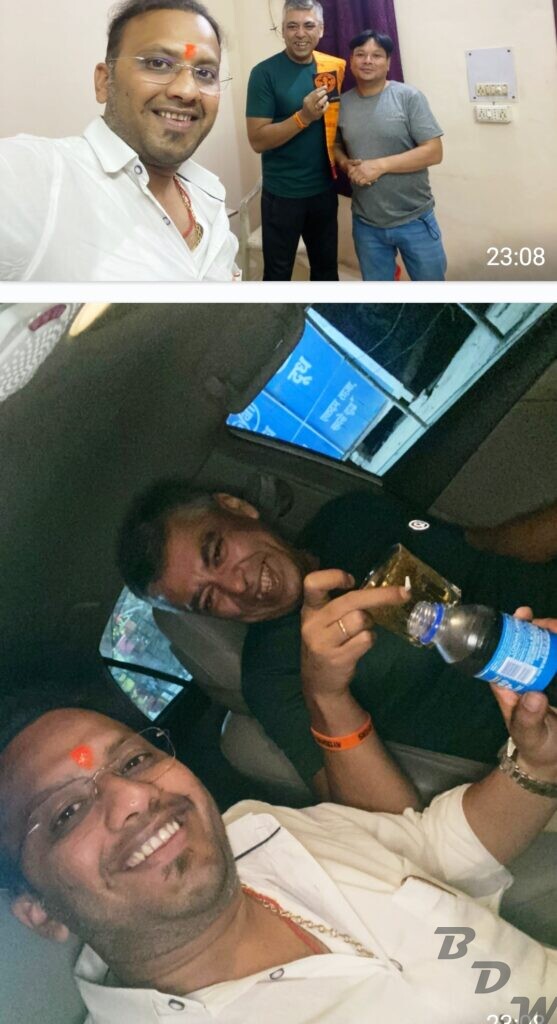
Visiting Old Lucknow
From 1350 onwards, Lucknow and parts of the Awadh region were ruled by the Delhi Sultanate, Sharqi Sultanate, Mughal Empire, Nawabs of Awadh, the British East India Company and the British Raj. For about eighty-four years (from 1394 to 1478), Awadh was part of the Sharqi Sultanate of Jaunpur. Emperor Humayun made it a part of the Mughal Empire around 1555. Emperor Jahangir (1569–1627) granted an estate in Awadh to a favoured nobleman, Sheikh Abdul Rahim, who later built Machchi Bhawan on this estate. It later became the seat of power from where his descendants, the Sheikhzadas, controlled the region. The Nawabs of Lucknow, in reality, the Nawabs of Awadh, acquired the name after the reign of the third Nawab when Lucknow became their capital. The city became North India’s cultural capital, and its nawabs, best remembered for their refined and extravagant lifestyles, were patrons of the arts. Under their dominion, music and dance flourished, and construction of numerous monuments took place. Of the monuments standing today, the Bara Imambara, the Chota Imambara, and the Rumi Darwaza are notable examples. One of the Nawab’s enduring legacies is the region’s syncretic Hindu–Muslim culture that has come to be known as the Ganga-Jamuni Tehzeeb
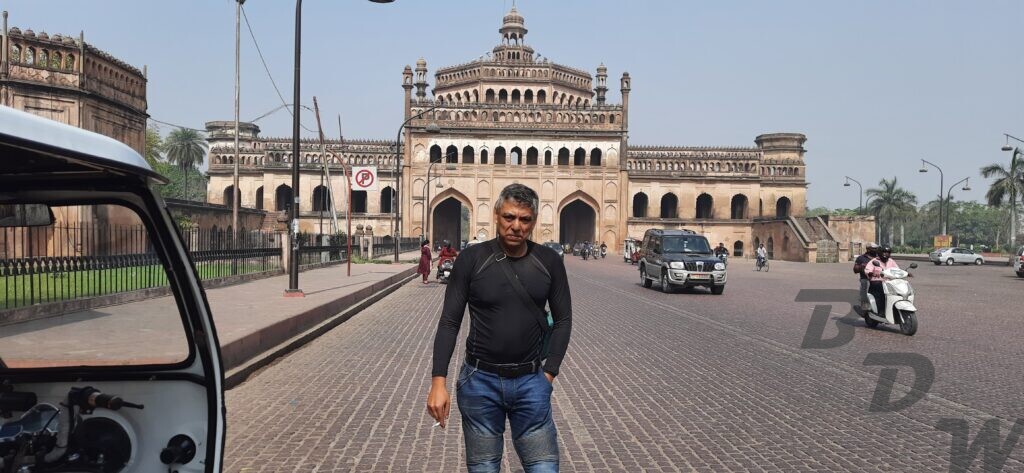
Rumi Darwaza 
Rumi darwaza Reverse view 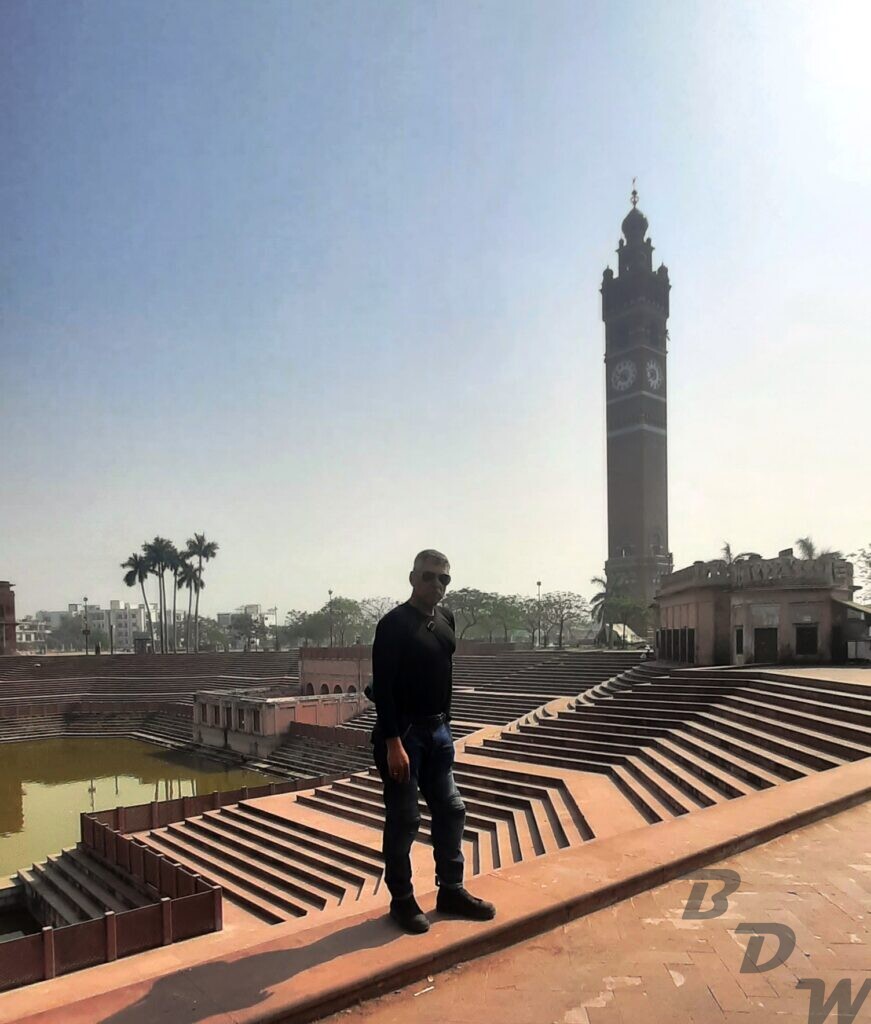
Ghantaghar and Fountain 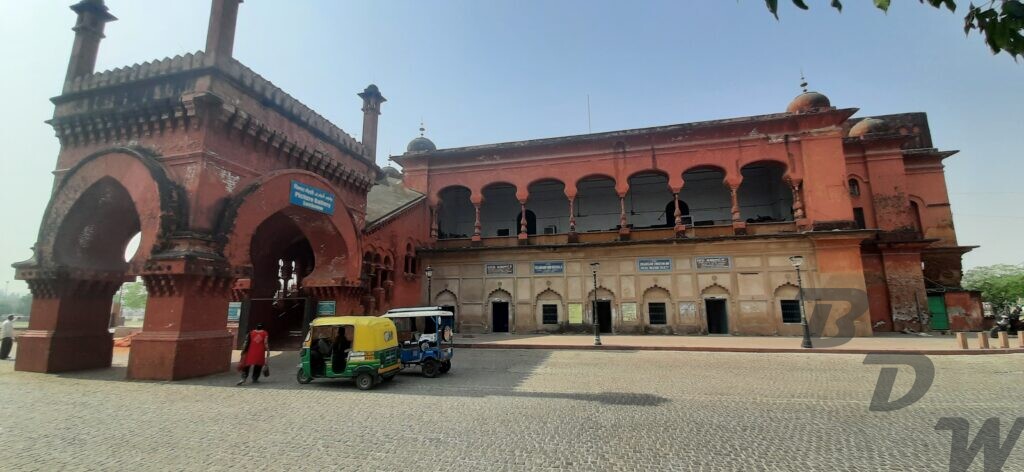
Lucknow Photo Gallery
Bada Imambara
Bara Imambara, also known as Asfi Imambara is an imambara complex in Lucknow, India built by Asaf-ud-Daula, Nawab of Awadh in 1784. Bara means big. This imambara is the second largest after the Nizamat Imambara. Construction of Bara Imambara was started in 1780, a year of a devastating famine, and one of Asaf-ud-Daula’s objectives in embarking on this grandiose project was to provide employment for people in the region for almost a decade while the famine lasted. It is said that ordinary people used to work in the day building up the edifice, while noblemen and other elite worked at night to break down anything that was raised that day. It was a project that preceded a Keynesian-like intervention for employment generation. Construction of the Imambara was completed in 1794. The estimated cost of building the Imambara ranges between half a million rupees to a million rupees. Even after completion, the Nawab used to spend between four and five hundred thousand rupees on its decoration annually. The building also includes the large Asfi mosque, the Bhul-bhulaiya (the labyrinth), and Bowli, a step well with running water. Two imposing gateways lead to the main hall. It is said that there are 1024 ways to reach the terrace but only two to come back first gate or the last gate. It is an accidental architecture.
The architecture of the complex reflects the maturation of ornamented Mughal design, namely the Badshahi Mosque – it is one of the last major projects not incorporating any European elements or the use of iron. The main imambara consists of a large vaulted central chamber containing the tomb of Asaf-ud-Daula. At 50 by 16 meters and over 15 meters tall, it has no beams supporting the ceiling and is one of the largest such arched constructions in the world. There are eight surrounding chambers built to different roof heights, permitting the space above these to be reconstructed as a three-dimensional labyrinth with passages interconnecting with each other through 489 identical doorways. This part of the building, and often the whole complex, may be referred to as the Bhulbhulaiya. Known as a popular attraction, it is possibly the only existing maze in India and came about unintentionally to support the weight of the building which is constructed on marshy land. Asaf-ud-Daula also erected the 18 meter (59 foot) high Roomi Darwaza, just outside. This portal, embellished with lavish decorations, was the Imambara’s west-facing entrance.
The design of the Imambara was obtained through a competitive process. The winner was a Delhi architect Kifayatullah, who also lies buried in the main hall of the Imambara. It is another unique aspect of the building that the sponsor and the architect lie buried beside each other. The roof of Imambara is made up from the rice husk which makes this Imambara a unique building.
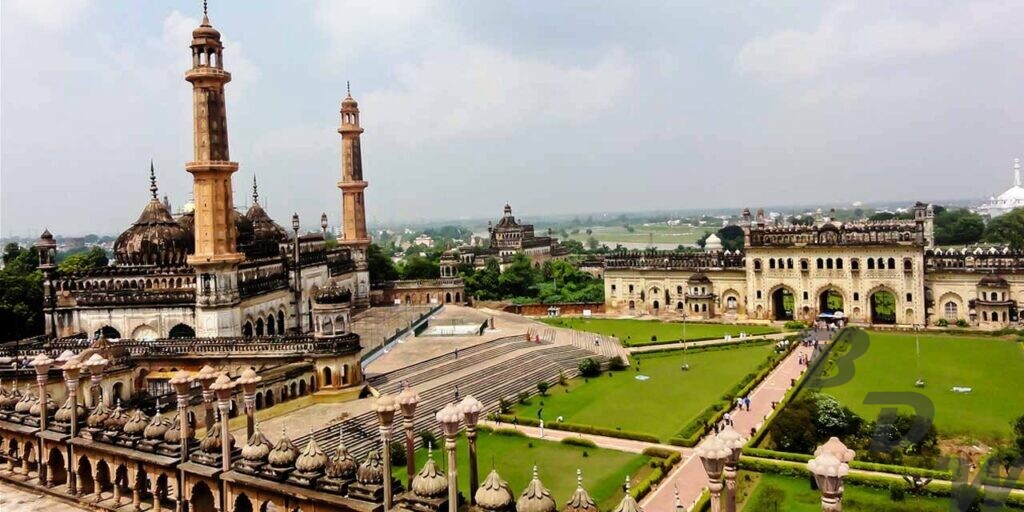
Bara Imambara 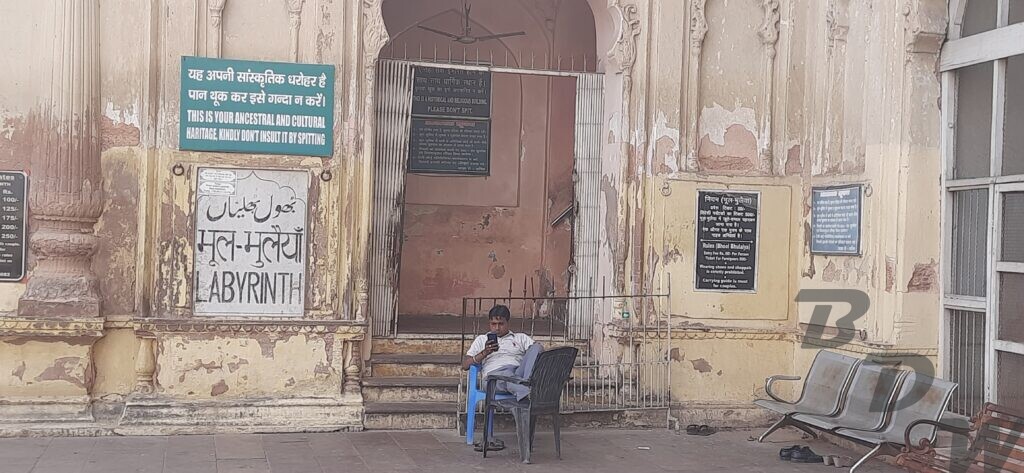
Entrance to Bhul Bhulaiya 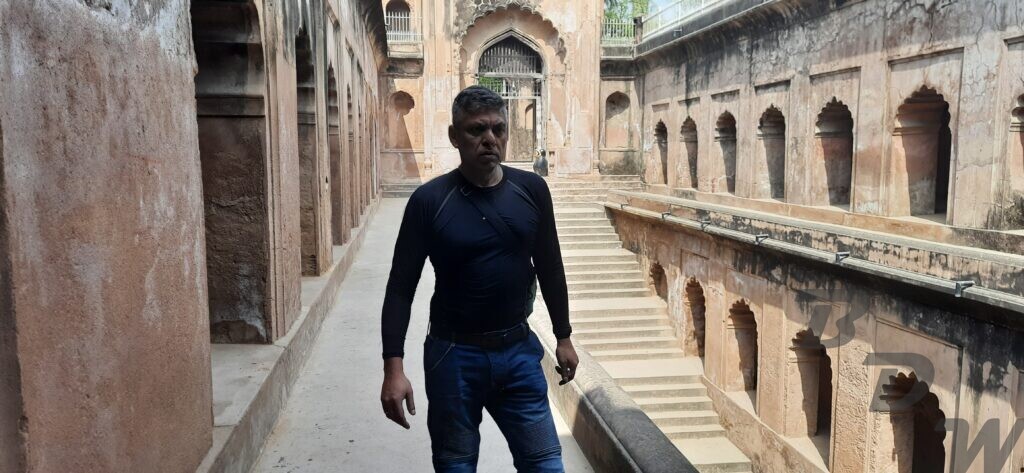
Stepwell or Bawri in Imambara 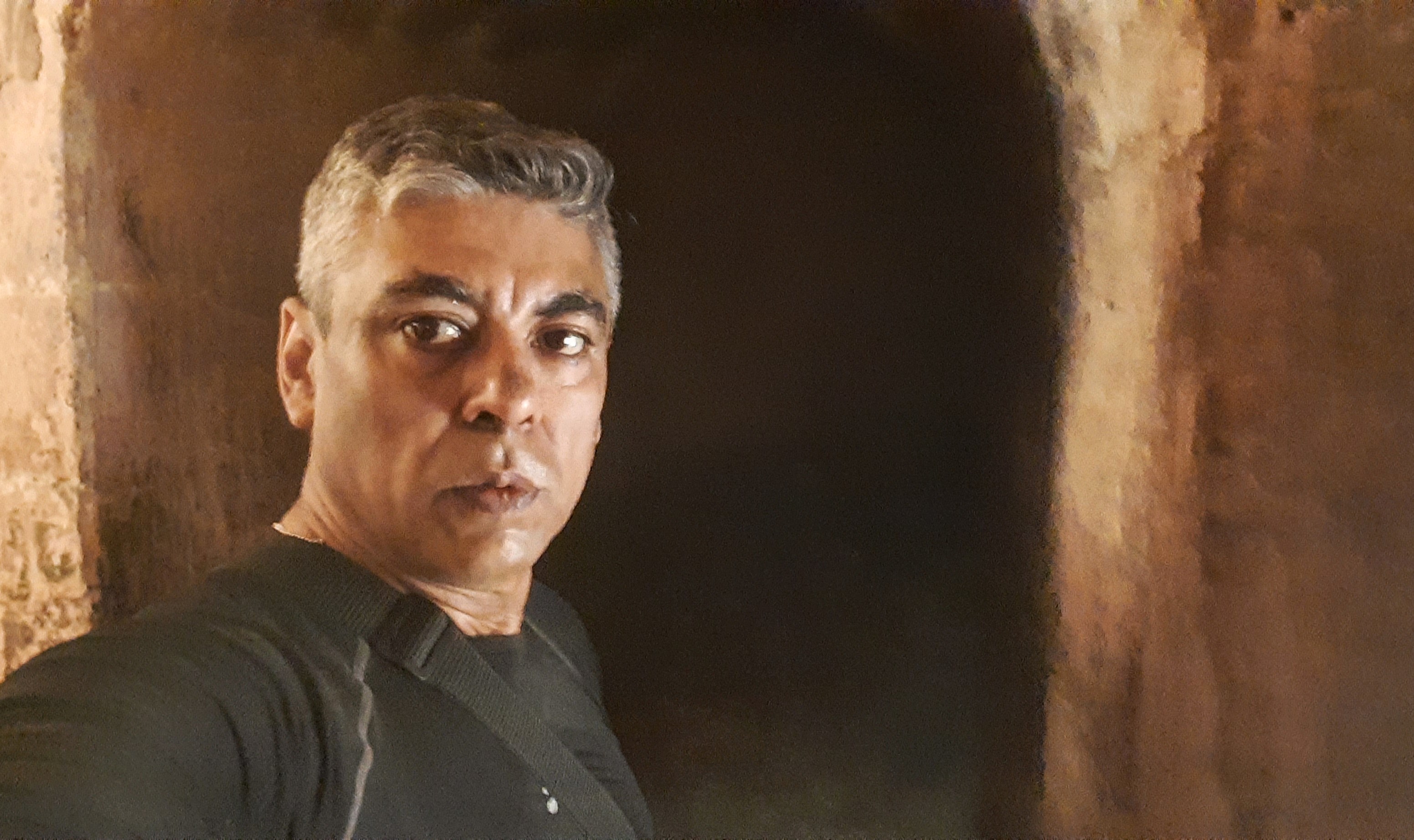
Inside the Bhul Bhulaiya
The Residency
The Residency, also called as the British Residency and Residency Complex, is a group of several buildings in a common precinct in the city of Lucknow, Uttar Pradesh, India. It served as the residence for the British Resident General who was a representative in the court of the Nawab. The Residency is located in the heart of the city, in the vicinity of other monuments like Shaheed Smarak, Tehri Kothi and High Court Building. Construction started during the rule of Nawab Asaf-ud-Daulah and ended during the rule of Nawab Saadat Ali Khan II, who was the fifth Nawab of the province of Awadh (British spelling Oudh). Construction took place between 1780 and 1800 AD. Between 1 July 1857 and 17 November 1857 the Residency was subject to the Siege of Lucknow, part of the Indian Rebellion of 1857. The Residency now exists as ruins.
The Residency has been maintained as it was at the time of the final relief, and the shattered walls are still scarred by cannon shot. Ever since Indian Independence, little has changed. The ruined building is now surrounded by lawns and flowerbeds and serves as a tourist attraction. The cemetery at the nearby ruined church has the graves of 2,000 men, women and children, including that of Sir Henry Montgomery Lawrence who died during the siege. There is a weathered epitaph near the grave of Sir Henry that reads “Here lies the son of Empire who tried to do his duty” while another nearby grave reads “Do not weep my children, for I am not dead, but am sleeping here.” A light and sound show to display the history of the Residency is also played each evening.
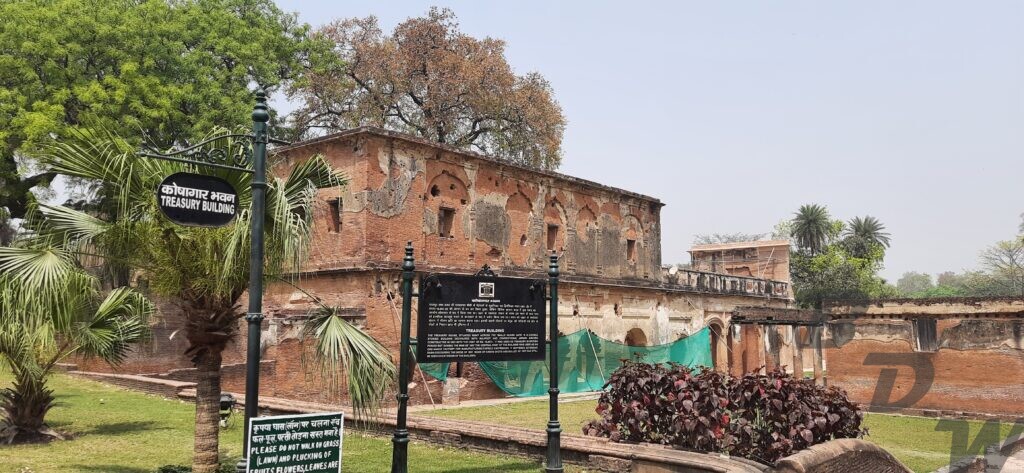
Shell and Gunshot ridden Treasury Building at Residency 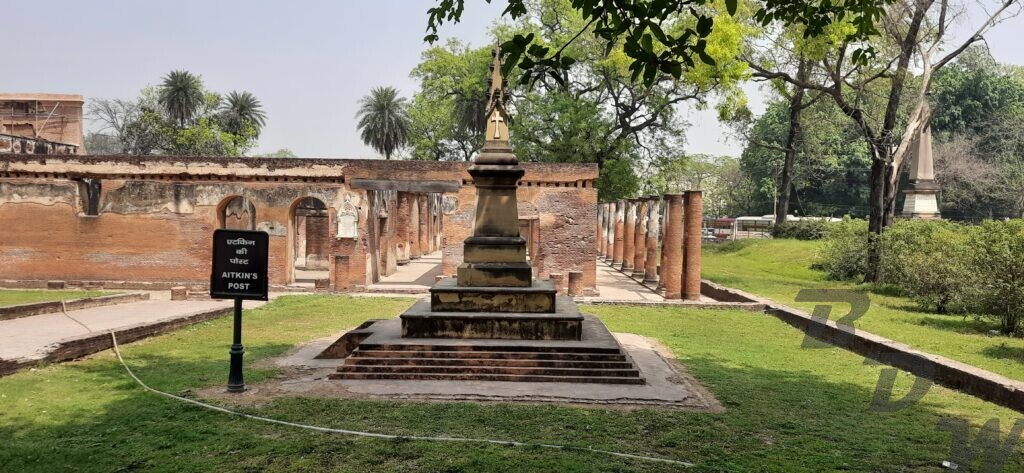
Where Captain Aitkins took the last stand against the sepoys 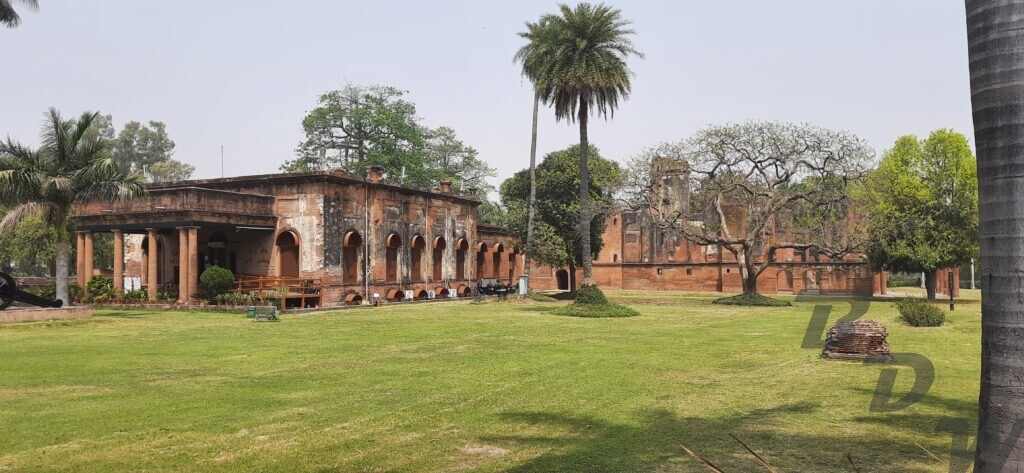
The Court Buiding 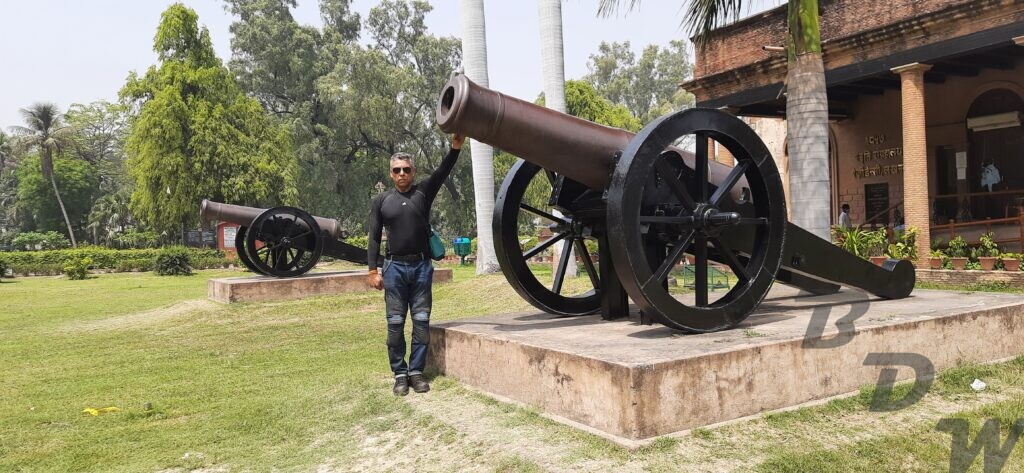
Artillery The Final Arguement of Kings
Evening Adda
The evening was a funfilled one with some taste of Kakori kabab with Babla da in the Hazratganj area, followed by drinks and dinner with some new friends made in the city. Finally it was the time to return Home, the next day.
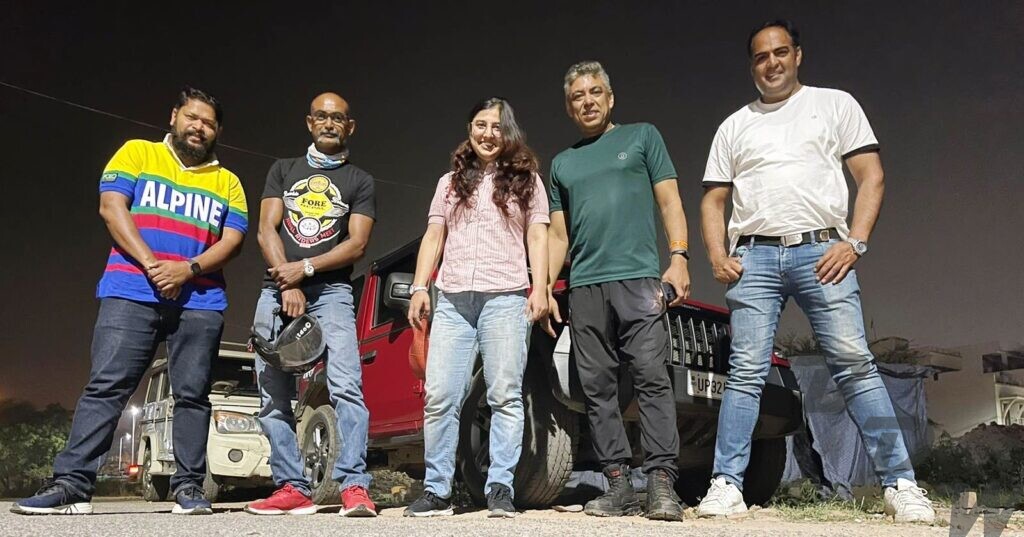


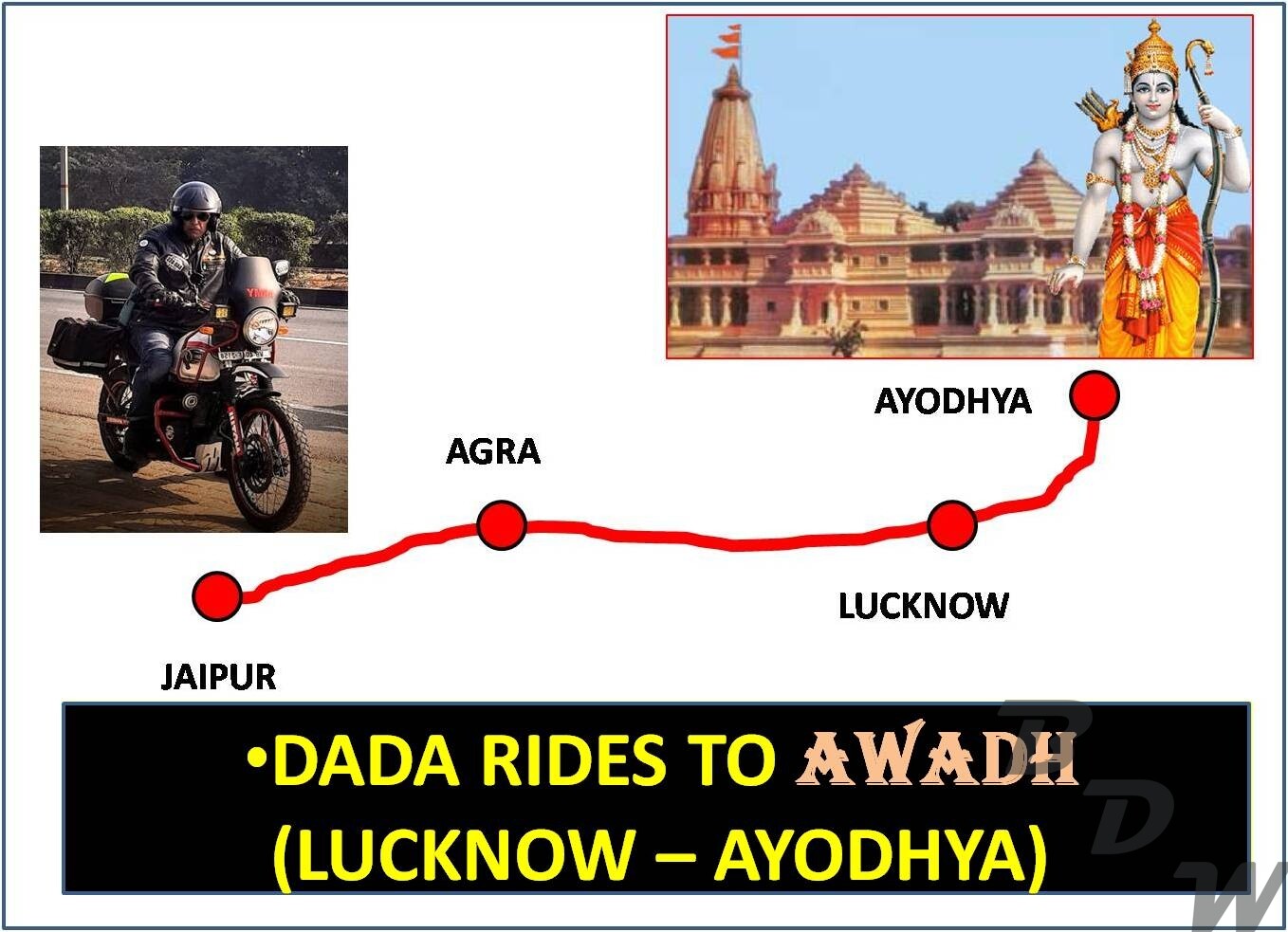


No Comment! Be the first one.